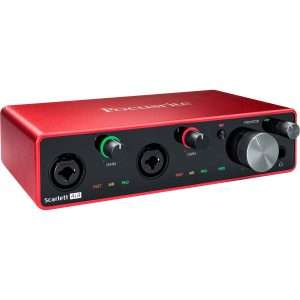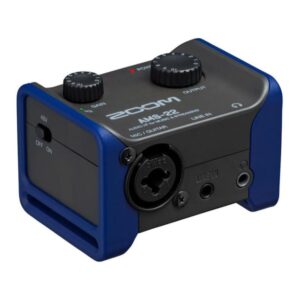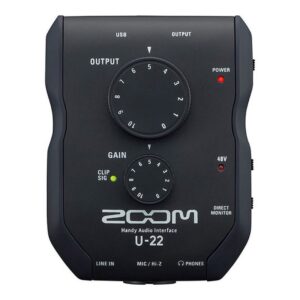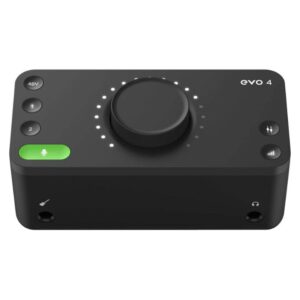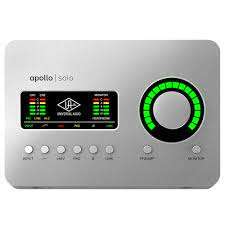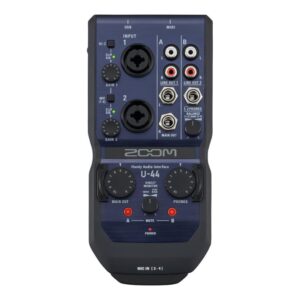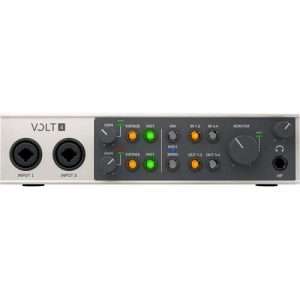Description
FOCUSRITE SCARLETT 2I2 2×2 USB AUDIO INTERFACE
The Focusrite Scarlett 2i2 3rd Gen was a hugely popular and successful USB audio interface, setting the standard for budget-friendly home studio recording for many years before the release of the 4th generation. It offered a significant upgrade over its predecessors and solidified the Scarlett series’ reputation for quality and ease of use.
Here’s a detailed look at the Focusrite Scarlett 2i2 3rd Gen:
Key Features of the Scarlett 2i2 3rd Gen:
- 2-in/2-out Configuration: Like its successor, it provides two inputs and two outputs, allowing for simultaneous recording of two sources (e.g., a vocal microphone and a guitar).
- Upgraded Scarlett Preamps: The 3rd Gen featured improved microphone preamps compared to previous generations. These preamps were known for their clean, transparent sound and provided a respectable 56dB of gain, making them suitable for most condenser and dynamic microphones.
- “Air” Mode: This was a standout feature introduced in the 3rd Gen. It’s a switchable mode that, when activated, models the sound of Focusrite’s legendary ISA transformer-based mic preamps. It adds a subtle high-end boost and an open, airy quality to vocals and acoustic instruments, giving them a more “produced” sound right at the source.
- High-Performance Converters: The 3rd Gen utilized 24-bit/192kHz AD/DA converters, ensuring high-fidelity audio capture and playback. This meant studio-quality sound with excellent detail and clarity.
- High-Headroom Instrument Inputs: The instrument inputs were designed to handle high-output guitars and basses without clipping, providing a clean and articulate signal. They automatically switched between instrument and line levels.
- Gain Halos: These intuitive LED rings around the gain knobs provided visual feedback on input levels. Green indicated a healthy signal, amber meant the signal was getting close to clipping, and red indicated clipping. This made it easy for users to set appropriate recording levels.
- Direct Monitoring: This feature allowed for near-zero-latency monitoring of input signals directly through the interface. You could toggle between mono and stereo direct monitoring, which was invaluable for performers who needed to hear themselves clearly without any distracting delay.
- USB-C Connectivity: The 3rd Gen adopted USB-C for connectivity, which was a modern and convenient standard at the time. It was also bus-powered, eliminating the need for an external power supply.
- Robust Build Quality: Housed in a durable, sleek red aluminum chassis with plastic front and back panels, the 2i2 3rd Gen was built to withstand the rigors of home studio use and portable recording.
- Bundled Software (“Hitmaker Expansion”): Like current Focusrite interfaces, the 3rd Gen came with a valuable software bundle. This typically included Ableton Live Lite, Avid Pro Tools | First Focusrite Creative Pack, a 3-month Splice Sounds subscription, and a collection of plugins from various developers like Antares (Auto-Tune), Softube (Time & Tone Bundle), XLN Audio (Addictive Keys), and Focusrite’s own Red Plug-in Suite. This provided a comprehensive set of tools for recording, mixing, and producing music.
- Compatibility: It was compatible with macOS, Windows, and iPadOS (with appropriate adapters).
Where the 3rd Gen Excelled (and still does):
- Simplicity and Ease of Use: It’s incredibly straightforward to set up and use, making it perfect for beginners.
- Sound Quality for the Price: For its price point, the 3rd Gen offered excellent audio quality, particularly with its clean preamps and the useful “Air” mode.
- Portability: Its compact size and bus-powered operation made it highly portable for recording on the go.
- Value Proposition: The combination of hardware quality and the included software bundle made it a fantastic value for money.
Comparison with 4th Gen (Key Differences):
While the 3rd Gen was excellent, the 4th Gen introduced several significant enhancements:
- Preamps: The 4th Gen features even lower-noise preamps with a wider gain range (up to 69dB in 4th Gen vs. 56dB in 3rd Gen). This means it can drive gain-hungry microphones more effectively with less noise.
- Dynamic Range: The 4th Gen boasts a higher dynamic range (up to 120dB vs. 111dB in 3rd Gen), offering a greater difference between the quietest and loudest possible sounds it can capture.
- “Air” Mode Evolution: The 4th Gen’s “Air” mode expanded to include “Harmonic Drive” in addition to the “Presence” boost, offering more tonal shaping options.
- New Features: The 4th Gen added “Auto Gain” (automatic level setting) and “Clip Safe” (automatic gain reduction to prevent clipping), which are extremely beneficial for beginners and live recording situations.
- Separate Power Port: The 4th Gen includes a dedicated USB-C power input (though still bus-powered for most uses), which can be useful for more demanding setups or connecting to devices with limited bus power.
- Physical Design Changes: The 4th Gen has a slightly revised aesthetic, including the relocation of the XLR inputs to the rear panel (allowing instruments to remain plugged in at the front).
- Headphone Output: The 4th Gen features a custom-designed headphone amplifier with greater power and clarity.
Is the 3rd Gen still a good choice?
Absolutely. While the 4th Gen offers improvements, the Scarlett 2i2 3rd Gen remains a highly capable audio interface. If you can find it at a good price, especially second-hand, it’s still a fantastic option for:
- Home studio recording: It provides all the essential features for recording vocals, guitars, and other instruments.
- Podcasting and streaming: Its clean preamps are excellent for vocal clarity.
- Budget-conscious users: It offers professional-level sound quality without breaking the bank.
Many professionals still use and recommend the 3rd Gen Scarlett interfaces due to their proven reliability and sound quality.

